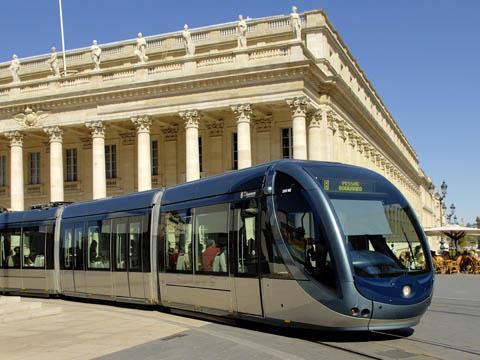
DESPITE an inauspicious start, when a series of technical failures with the APS ground-level power supply system affected the inauguration by President Chirac on December 21 2003, all three lines in the first phase of the Bordeaux tram network are now operational and well-used. One extension has opened, and seven more are on course to be completed in 2007-08.
Line A services initially linked Mériadeck in the city centre with Lormont Lauriers and Cenon La Morlette on the east bank of the Garonne (RG 2.04 p87). The western end has since been extended to Saint-Augustin. Works are now well advanced on an extension of the Cenon branch to Floirac, which is due to open in February 2007. In June of next year Line A will be continued further west from Saint-Augustin to Mérignac, towards but not reaching the city's airport. Finally, the Lormont branch is to be extended to form a loop through Carbon-Blanc and Bassens by May 2008.
Inauguration of Line B was postponed because of the APS problems, and it was not until July 2004 that trams began running between Esplanade des Quinconces and Talence; this route was subsequently completed to Bougnard, serving the university district. From May 2007 Line B will be extended to Pessac, where it will interchange with SNCF's Bordeaux - Irun line.
Perhaps the most visible extension project in Bordeaux is the northern extension of Line B from Quinconces to the development zone at Claveau (above right). This involves the widening of the main bridge over the tidal basin at Bacalan. Track is already being laid along the west bank of the river past the naval museum cruiser Le Colbert, even though the extension is not expected to open until December 2008. There will be a second stabling depot along this section, supplementing the main workshop complex on a branch off Line A east of the river.
The short north-south Line C linking Esplanade des Quinconces with Gare St-Jean was the second route to open, in April 2004. By March 2008 it will be extended over the railway and south to Bosc, which is expected to spur the revitalisation of the suburb of Bègles. Requiring the doubling of the Pont de Guit near the station, this will also offer improved connections to SNCF. At present there is little evidence of any work on this extension, but by contrast there has been considerable progress on the northern extension of Line C to Bordeaux-les-Aubiers which is due to open in November 2007.
The seven extensions will increase the overall length of the tram network from 24·5 km to 43·8 km, and add a further 35 stops, bringing the total to 84. Daily patronage is expected to increase from 170000 to 280000, with much of this generated by the 16 park-and-ride facilities across the expanded network. More than 2600 parking spaces were provided in Phase I; almost as many more should be available by 2007-08.
Phase I is operated by 44 articulated trams supplied by Alstom. Six are five-section Citadis 302 cars used on Line C and the rest are seven-section Citadis 402 cars. Another 30 are required for Phase 2, of which 24 will be the longer variety. Once these have been delivered, it will be possible to run a 4min interval service on all three routes.
The only cloud on the horizon is a degree of uncertainty over the funding for the second phase. The complete network was originally estimated to cost €1·05bn at 2005 prices, of which Phase 1 accounted for €646m. This was 65% funded by the Communauté Urbaine de Bordeaux and 15% by the central government, with the remainder raised through loans.
The French government subsequently cut back its support for regional investment, leaving a €66m shortfall in the funding for Phase 2. Bordeaux is clearly confident that this problem can be resolved, as the extension works are progressing rapidly.
It is clear that the tramway has already made a significant contribution towards the renaissance of Bordeaux. This is exemplified by newly-cleaned buildings, pedestrian areas, modern street furniture, grassed reservations and tree lined avenues. Almost 1600 trees were planted during Phase 1 alone, and the avenues at Esplanade des Quinconces are particularly attractive.
The general ambience of the city centre is also enhanced by the absence of overhead wires in environmentally sensitive areas, despite the higher costs and teething problems for the ground-level supply.




















